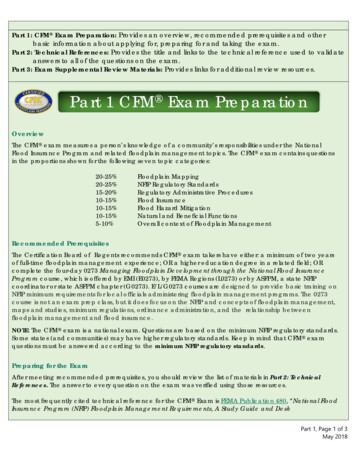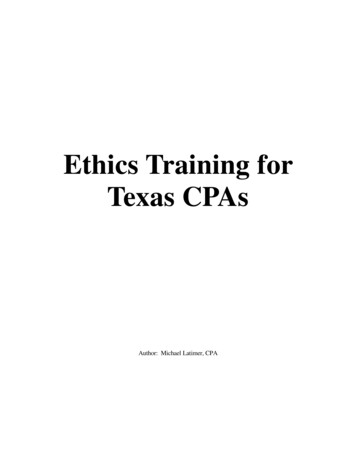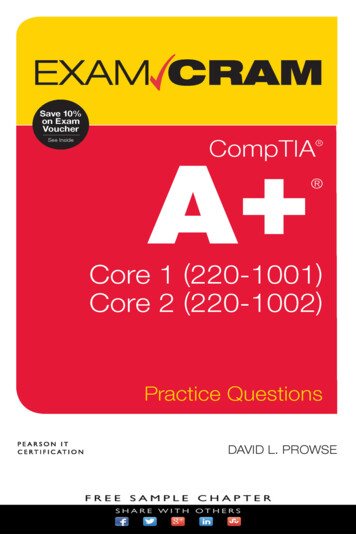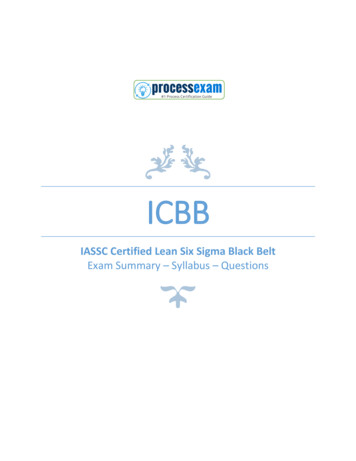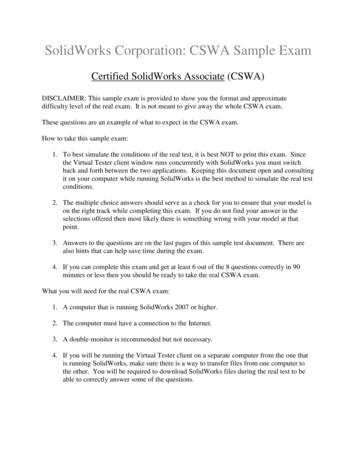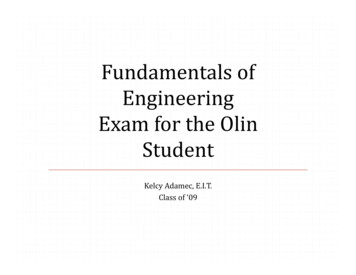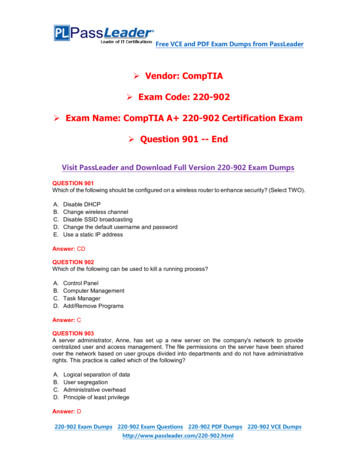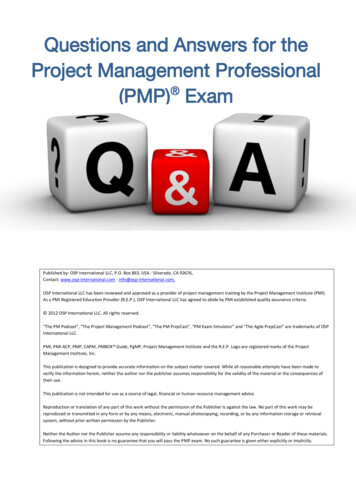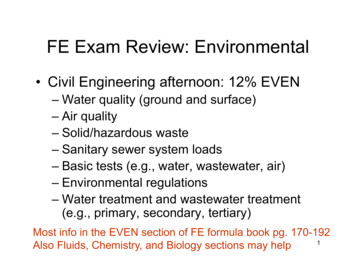
Transcription
FE Exam Review: Environmental Civil Engineering afternoon: 12% EVEN– Water quality (ground and surface)– Air quality– Solid/hazardous waste– Sanitary sewer system loads– Basic tests (e.g., water, wastewater, air)– Environmental regulations– Water treatment and wastewater treatment(e.g., primary, secondary, tertiary)Most info in the EVEN section of FE formula book pg. 170-1921Also Fluids, Chemistry, and Biology sections may help
FE Exam Review: EnvironmentalEVEN majors or if you concentrated in environ. & proficient in water EVEN afternoon: (60 ?s; pg. 170-192)– Water Resources (distrib/coll, hydrol, fluids) 25% See CVEN pg. 159-161,– Water & WW (inc. micro/ecol see p. 91-99, env chem) 30%– Air Quality Engrg (stds, control, atm sci) 15%– Solid & Hazardous Waste Engrg 15% SW, HazW, site remediation, geohydrology, geotechnology– Env Science & Management 15% OSHA, radiation health/waste mgmt, env monitoring & sampling,pollutant fate & transport (soil/air/water), pollution prevention 2
TIPS Watch units!– Water: ppm mg/L; ppb μg/L;– Soil: ppm mg/kg;– Air ppm IS NOT mg/L! AIR conc in ppm-v 100-1000x air in mg/L– Need molecular weight; molar volume– Pg. 19-20 of formula book has conversion factors Frequently, you will use a MASS BALANCE approach Review your CVEN 3414 homeworks/text;– Review CVEN 3424 if you had the course Practice problems from: Metcalf & Eddy WastewaterEngrg; LaGrega Haz Waste; Wark & Warner AirPollution; Vesilind et al. Solid Waste Engineering; Ray3Environmental Engineering
Environmental Regulations Clean Water Act– NPDES permits for discharge to surface waters Safe Drinking Water Act (SDWA)– Sets MCLs for acceptable concentrations of contaminants in publicdrinking water supplies; sets treatment requirements for pathogens Clean Air Act (CAA) set National Ambient Air Quality Stds– Regulates criteria pollutants (CO, ozone, NOx, SOx, PM, lead)– Regulates hazardous air pollutants and sets Max Achiev Control Tech Resource Conservation and Recovery Act (RCRA)– Hazardous Waste Subtitle C (cradle to grave, defined HazW)– Solid waste Title D, Medical waste Subtitle J, Underground storagetanks Subtitle I Comprehensive Environmental Response, Compensation, andLiability Act (CERCLA; “Superfund”)– Clean up worst historically contaminated sites in the US OSHA (Occupational Safety and Health Administration)– Safety for workers; such as HAP concs in air National Environmental Policy Act (NEPA)– Requires Environmental Impact Statements (EIS) for federal projects4
Water Quality Wastewater– Solids: TDS, VDS, TSS, VSS– BOD5 or CODp. 175 BOD5 BODu (1 – e-kt), if k is base e deoxygenationrate constant (sometimes use base 10)– Organic nitrogen (as N)– Ammonia nitrogen (NH3-N)– TKN organic N ammonia N– Total phosphorus5
WasteWater Tmt (p. 186-190) Activated sludge: plug flow or CMFR, biomasseqn; typical operating parameters Clarifier [primary, secondary]– mass balance; design by overflow rate, HRT– SVI sludge volume index (settlability) Aerobic digestion HRT, solids load, O2 Anaerobic digestion SRT, solids load, CH4 Facultative pond BOD loading, depth, HRTDisinfection chlorine (CT) or UV common6
Water Tmt (w/ww class) GAC sorption & isotherms (also HazW)– Removes organics Air stripping (also HazW) – remove volatilesSedimentation/clarifiers – remove particlesFiltration – remove based on sizeSoftening – remove hardness (Ca 2, Mg 2, )Flocculation – agglomerate to larger particlesMembranes – RO (desalination), NF, UF, MFDisinfection – chlorine, UV, ozone, chloramine 7
Fate and Transport Streeter Phelps for oxygen sag in streamwhen ww with BOD is discharged (p. 175)– DO sag curve– Oxygen saturation conc. at 20oC is 9.1 mg/L Monod Kinetics – describe bacterialgrowth and substrate degradation;– dX/dt umax S X / Ks S – bX -YdS/dt - bX– -dS/dt umax/Y * SX / Ks S8
Fate & Transport: BCF, Kow, Koc,Ksw, R (HazWclass) If a chemical has a BCF of 20, what is the likelyconcentration of the chemical in fish that live inwater containing 10 ppm of the chemical?– BCF * Cw Cfish; ppm mg/kg Chemicals A, B, and C have Koc values of 10,100, and 1000. Which will travel fastest in GW?– If the soil has an organic carbon content of 3%, whatis the Ksw of Chemical B?– P.1769
Air Pollution Unit conversions Model by Gaussian dispersion– 4 pages in FE reference handbook! Treatment– remove particles: CycloneBaghouseElectrostatic precipitator– Remove organics (HAPs) by incineration– Wet scrubbing removes acid gases10
Radiation (HazW) What type of nuclear radiation has the greatestpenetrating power?– Gamma Beta Alpha Which type of nuclear radiation causes thegreatest molecular damage when ingested?– Alpha (20x other particles) If a soil sample contains 10 mg/L of aradioisotope with a half life of 100 yrs, what willbe the concentration of the radioisotope in thesoil after 1000 yrs?– Pg. 17811
Toxicology and risk assessment Threshold concept for non-carcinogens and acute effects––––Risk if intake threshold (such as RfD)Hazard Index chronic daily intake / RfDIntake and dose in mg chemical/kg body wt/dRfD usually estimated from animal studies with multiple orders ofmagnitude of UFs Carcinogens risk dose:response without threshold– Incremental cancer risk dose * Carcinogen Slope Factor (CSFor CPF) Dose Intake CDI Conc * CR * Abs * Ret * EF * ED / Body wt / Avg timeavg time ED for non-carcinogens or 70 yr lifetime forcarcinogensPg. 184 for CDI formulas; Pg. 185 for CR and body wt12
Example ?s A 5-day BOD and ultimate BOD aremeasured at 180 mg/L and 200 mg/L,respectively. What is the decaycoefficient?– Use eqn. pg. 17513
Example ?s The carbonaceous oxygen demand of 200mg/L of C5H7NO2 is The nitrogenous oxygen demand of 200mg/L of C5H7NO2 isWrite stoichiometry for mineralization to CO2 NH3; then NH3 to HNO3;Balanced stoichiometry rules: each element balanced on both sides;charge balanced on both sidesConvert from moles to mg (use periodic table pg. 101)14
Example ?s A lake with volume 5E6 m3 has afreshwater flow of 20 m3/s. Waste isdumped into lake at 50 g/s with a decayrate of 0.2/d. What is the steady statecontaminant concentration in the lake inmg/L if the lake is completely mixed?Mass Balance OR eqn. on pg. 17615
W&WW A wastewater basin has a diameter of 20m and water depth of 3 m. The pipefeeding the basin has a diameter of 40 cm,is flowing full, and has a water velocity of0.28 m/s. What is the hydraulic residencetime in the basin?HRT Volume / Q16
Risk Assessment/Tox (HazW class) Calculate the chronic daily intake of arsenic byan average adult if their drinking water over theirentire lifetime contains 10 ppm arsenic.– What is the CDI if the drinking water only containedarsenic for 10 yrs Carcinogen (averaging time 70 yr lifetime) Non carcinogen (averaging time exposure time)– What is the carcinogenic CDI if only the drinkingwater at their work contained this amount of arsenic,and they worked there for 10 yrs17
Air Pollution Convert 20 ppm of NO2 to μg/m3 at 20C.– ppm mol NO2/ 1E6 mol * 46 g/mol * 1 mol air/24 Lair g/L * 1E6 ug/g * 1000 L/m3 An Illinois coal with a sulfur content of 3.00% isburned at a rate of 1 kg/sec. If 5% of the sulfurgoes into the ash, what is the mass emissionrate of SO2 into the air per year?– Mass 1 kg/sec * 0.03 kg S/kg coal * 0.95 * (MWSO2 / MW S) * sec/yr Determine the efficiency of a conventionalcyclone with 0.5 m barrel diameter for removing10 um particles with a density of 800 kg/m3 from4 m3/s of air at 25C.– See p. 173: eff 1/1 (d50/dp)2 and d50 eqn.18
Air Pollution It is estimated that 1700 g/s of SO2 are emittedfrom a coal fired power plant. At 3 km downwindon an overcast summer afternoon, what is thecenterline concentration of SO2 if the windspeedis 4.5 m/s? The stack is 120 m high, 1.2 mdiameter, with gas exiting at 1 m/s and 315oC.The atmosphere is 25oC.– Plume rise 8 m vs d / u * [ const P (Ts-Ta/Ts)d] byHolland’s formula (not given in book; 6% errorneglect OK)p. 170 and 17119
More questions How many grams of oxygen are requiredto burn 1 gram of methane (CH4)?– Write balanced chemical reaction:–CH4 2 O2 - CO2 2 H2O– Convert from moles to g (see pg. 101 periodictable)– 1 g CH4 * 1 mol/16 g * 2 mol/1 mol * 32 g– 4 g O220
Disinfection: Which statements arecorrect?1. Chlorination of wastewater effluents requires morechlorine than chlorination of drinking water2. Chlorination of ww effluents requires 3 moles ofchlorine for each mole of ammonia3. Chlorination of ww is used to improve effluent quality4. Chlorination of ww effluents oxidizes other chemicalssuch as ferrous irona) All above are trueb) None of above are truec) Only 1 and 3 are trued) Only 1, 3, and 4 are true21
You are designing a biological treatment reactorthat is a CSTR to achieve an effluentconcentration of 1 mg/L of benzene. The inlet of1 MGD contains 50 mg/L benzene. Whichbacteria will allow the smallest reactor?A: Cell yield 0.5 g/g, maximum specific growth rate1/day, half saturation constant 1 mg/LB: Cell yield 0.5 g/g, maximum specific growth rate10/day, half saturation constant 1 mg/LC: Cell yield 0.5 g/g, maximum specific growth rate10/day, half saturation constant 10 mg/LD: Cell yield 0.2 g/g, maximum specific growth rate1/day, half saturation constant 1 mg/Lp. 175 and 18622
W/WW A water contains silt particles with auniform diameter of 0.02 mm and aspecific gravity of 2.6. What removal isexpected in a clarifier with an overflow rateof 12 m/d?– Need Stokes Law formula p. 192– Need density and viscosity of water (p. 62density); viscosity 1E-3 N s / m2– Fractional removal settling velocity /overflow23
W&WW A completely mixed reactor with cell recycle isdesigned to treat a municipal waste. AssumingMonod removal kinetics, which of the followingstatements is correct A) effluent substrate concentration decreaseswith an increase in SRT B) food:microorganism ratio is independent ofSRT C) microbe concentrations will be smaller than inthe no-recycle case D) SRT is independent of effluent qualityp. 18624
W&WW A wastewater contains contaminant A with aninitial concentration of 1200 mg/L. A isbiodegraded via a first order reaction with a rateconstant of 2.5 per day. Determine the timeneeded in a batch reactor to degrade 75% ofcontaminant A. Under the same conditions as above, whatdetention time is needed if the ww is treated in aCSTR with a flowrate of 0.02 m3/s.p. 17625
W&WW A 25-m diameter secondary clarifier hasan influent solids concentration of 2500mg TSS/L. The flow rate to the clarifier is17,500 m3/d. If the effluent solids areassumed to be zero, what return or recycleflow rate is required to attain a returnsolids concentration of 7500 mg TSS/L.26
1 liter of water is at equilibrium with anatmosphere containing a partial pressureof 0.1 atm of CO2. How many grams ofCO2 are dissolved in the water (alpha 1/H 2.0 g/L/atm)27
How much HOCl is present in a solutioncontaining 0.1 M chlorine at pH 8 if theequilibrium constant is 10-7.5?– Use pH to determine H concentration– Write equilibrium equation– HOCl H OCl– Use pg. 100 equilibrium constant formula tosolve for HOCl (assume chlorine conc is totalof HOCl OCl-)28
Wastewater with DO concentration of 1mg/L is discharged to a river at 20C. Theriver is saturated with oxygen. If the flowof the river is 2.8 m3/s and flow of thewastewater is 2.8E-2 m3/s, what is theoxygen deficit immediately after mixing?– Find saturated oxygen conc (it is significantlyimpacted by temperature; should be given inthe problem)29
A waste with flow 2.8 L/s (DO 1 mg/L) isdischarged to a clean stream with flow 14L/s (fully O2 saturated). Waste has 5-dBOD of 200 mg/L (k 0.2/d). What is theDO after 1 day’s travel in the stream?assume deoxygenation rate is 0.12/d andreaeration rate is 0.5/d30
Problem Town A wants to discharge 0.28 m3/s ww (temp20C) with DO 1 mg/L and ultimate BOD of 6.44mg/L into a stream (temp 20C) with flow 0.877m3/s at upstream DO 6 mg/L and BODu of 0. Will the DO at town A drop below 5 mg/L? At any point in the river will DO drop below 5mg/L? assume deoxygenation rate is 0.12/d andreaeration rate is 0.5/d.tc 1* ln [reaer (1 – Do (reaer-deoxy)](reaer – deoxy)deoxy(deoxy BODu)D deoxy BODu/(reaer-deoxy) * [exp(-deoxy t) – exp(-reaer t)] Do exp(-reaer t)D DOsat - DOactualWW chloride 100 mg/L; so DOsat 9.16 mg/L (A-51)31
1. Water ResourcesA centrifugal pump has a flow rate of 1 L/s for arotational speed of 2000 rpm. Assuming aconstant impeller diameter, the flow rate for arotational speed of 3000 rpm is most nearly(A)0.75 L/s(B) 1.5 L/s(C) 2.0 L/s(D)3.0 L/s
2. Water ResourcesThe population of a town was 1.1 million in1980, 1.2 million in 1990, and 1.3 million in2000. The per‐capita consumption of water was0.5 kg/person/d in 1970 and 0.7 kg/person/d in1990. The total water consumption in 2010 isexpected to be(A)9.0E5 kg/d(B) 1.2E6 kg/d(C) 1.3E6 kg/d(D)1.4E6 kg/d
3. Water and WastewaterA sample of wastewater has a kinetic rate constantof 0.1/d. The initial dissolved oxygen reading is 8.00mg/L. The reading after 2 d without any additionaloxygen being added is 6.0 mg/L. Therefore, theultimate BOD is most nearly(A) 2.0 mg/L(B) 9.0 mg/L(C) 11 mg/L(D) 21 mg/L
4. Water and WastewaterThe equilibrium constant, Keq, is 5E‐11 mol/L forthe reactionHCO3‐ H CO32‐The molar concentration of HCO3‐ at a pH of 7.5 ismost nearly(A) 3.8E‐10 mol/L(B) 4.0E‐5 mol/L(C) 2.0E‐5 mol/L(D) 1.0 mol/L
5. Air Quality EngineeringA plume is emitted from a 20 m high stack. Wind speed isconstant at 3 m/s, there is no wind shear, and the topographyis flat. The plume’s point of maximum rise occurs at adownwind distance of 600 m from the stack. The emissionsfrom the stack have a buoyancy flux of 55 m4/s3. Prior to thepoint of maximum plume rise, the vertical distance betweenthe top of the stack and the centerline of the plume can bemodeled asΔh (1.6F1/3x2/3)/µThe height of the plume’s centerline above the ground at adistance of 0.4 km downwind of the stack is most nearly(A) 110 m(B) 130 m(C) 140 m(D) 160 m
6. Solid & Haz. Waste EngineeringA city has municipal solid wastewith the following characteristicsThe pass percent of water in thesolid waste is most nearly(A) 12.0(B) 23.9(C) 35.9(D) 47.8WasteComponentMass % (dry basis)Food3.2Glass0.2Metal1.2Plastics18.9Wood debris3.8Paper15.8Yard waste33.0
7. Solid & Haz. Waste EngineeringSome soil has a discharge rate of 0.1 L/s, an area of11 m2, and a hydraulic head that is given empiricallyby the functionH 0.03x 0.3The units of H and x in this equation are in meters.The hydraulic conductivity of this soil is most nearly(A) 3E‐4 m/s(B) 3E‐3 m/s(C) 3E‐2 m/s(D) 3E‐1 m/s
3 TIPS Watch units! - Water: ppm mg/L; ppb μg/L; - Soil: ppm mg/kg; - Air ppm IS NOT mg/L! AIR conc in ppm-v 100-1000x air in mg/L - Need molecular weight; molar volume - Pg. 19-20 of formula book has conversion factors Frequently, you will use a MASS BALANCE approach Review your CVEN 3414 homeworks/text; - Review CVEN 3424 if you had the course

